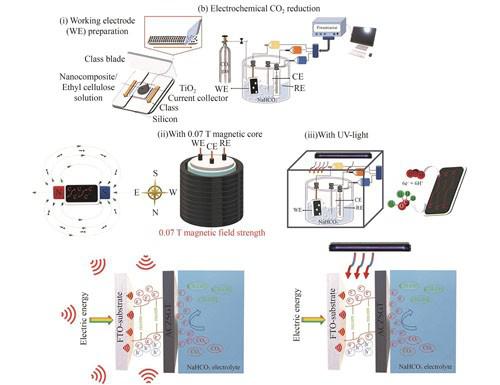Frontiers of Chemical Science and Engineering ( IF 4.3 ) Pub Date : 2022-07-02 , DOI: 10.1007/s11705-022-2166-y Zambaga Otgonbayar , Kwang Youn Cho , Chong-Hun Jung , Won-Chun Oh

|
The development of CO2 into hydrocarbon fuels has emerged as a green method that could help mitigate global warning. The novel structured photocatalyst is a promising material for use in a photocatalytic and magneto-electrochemical method that fosters the reduction of CO2 by suppressing the recombination of electron—hole pairs and effectively transferring the electrons to the surface for the chemical reaction of CO2 reduction. In our study, we have developed a novel-structured AgCuZnS2—graphene—TiO2 to analyze its catalytic activity toward the selective evolution of CO2. The selectivity of each nanocomposite substantially enhanced the activity of the AgCuZnS2—graphene—TiO2 ternary nanocomposite due to the successful interaction, and the selectivity of the final product was improved to a value 3 times higher than that of the pure AgCuZnS2 and 2 times higher than those of AgCuZnS2—graphene and AgCuZnS2—TiO2 under ultraviolet (UV)-light (λ = 254 nm) irradiation in the photocatalytic process. The electrochemical CO2 reduction test was also conducted to analyze the efficacy of the AgCuZnS2—graphene—TiO2 when used as a working electrode in laboratory electrochemical cells. The electrochemical process was conducted under different experimental conditions, such as various scan rates (mV·s−1), under UV-light and with a 0.07 T magnetic-core. The evolution of CO2 substantially improved under UV-light (λ = 254 nm) and with 0.07 T magnetic-core treatment; these improvements were attributed to the facts that the UV-light activated the electron-transfer pathway and the magnetic core controlled the pathway of electron-transmission/prevention to protect it from chaotic electron movement. Among all tested nanocomposites, AgCuZnS2—graphene—TiO2 absorbed the CO2 most strongly and showed the best ability to transfer the electron to reduce the CO2 to methanol. We believe that our newly-modeled ternary nanocomposite opens up new opportunities for the evolution of CO2 to methanol through an electrochemical and photocatalytic process.
中文翻译:

新型石墨烯基三元纳米复合材料用于磁光催化还原 CO2 并具有电化学性能
将 CO 2开发成碳氢化合物燃料已成为一种有助于减轻全球警告的绿色方法。这种新型结构光催化剂是一种很有前途的材料,可用于光催化和磁电化学方法,通过抑制电子-空穴对的复合并有效地将电子转移到表面进行 CO 2 还原的化学反应来促进 CO 2的还原。 . 在我们的研究中,我们开发了一种新型结构的AgCuZnS 2 -石墨烯-TiO 2来分析其对CO 2选择性演化的催化活性。每种纳米复合材料的选择性显着增强了 AgCuZnS 2的活性—石墨烯—TiO 2三元纳米复合材料由于成功的相互作用,最终产物的选择性提高到纯AgCuZnS 2的3倍和AgCuZnS 2的2倍—石墨烯和AgCuZnS 2 — TiO 2在光催化过程中在紫外 (UV) 光 ( λ = 254 nm) 照射下。还进行了电化学CO 2还原试验以分析AgCuZnS 2 -石墨烯-TiO 2的功效。在实验室电化学电池中用作工作电极时。电化学过程是在不同的实验条件下进行的,例如各种扫描速率(mV·s - 1)、紫外光和 0.07 T 磁芯。在紫外光 ( λ = 254 nm) 和 0.07 T 磁芯处理下,CO 2的释放显着改善;这些改进归因于紫外光激活了电子转移路径,而磁芯控制了电子传输/阻止路径以保护其免受混乱电子运动的影响。在所有测试的纳米复合材料中,AgCuZnS 2 -石墨烯-TiO 2吸收了CO 2最强烈并显示出最好的电子转移能力以将CO 2还原为甲醇。我们相信,我们新建模的三元纳米复合材料为通过电化学和光催化过程将 CO 2转化为甲醇开辟了新的机遇。











































 京公网安备 11010802027423号
京公网安备 11010802027423号